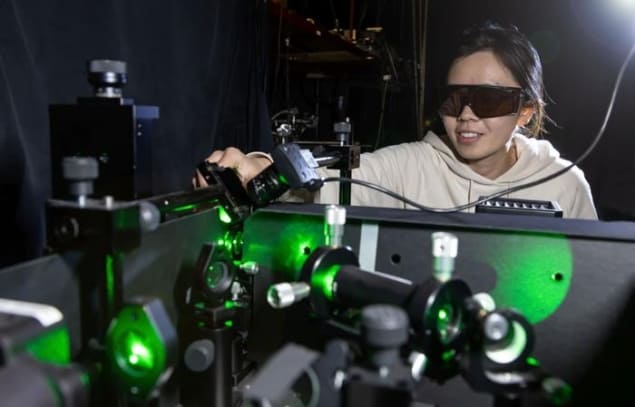
The remarkably high efficiency of solar cells made from materials called perovskites has puzzled scientists for nearly 20 years. Now, researchers at Forschungszentrum Jülich (FZJ) in Germany say they have found an explanation. By studying the materials’ photoluminescence over a wide dynamic range, they showed that free charge carriers (electrons and holes) in perovskite solar cells recombine very slowly, increasing the carriers’ lifetimes and boosting the cells’ efficiency. Their work also revealed that shallow defects in the material play an important role in recombination when it occurs – knowledge that could help scientists increase efficiencies still further.
Solar cells generate electricity when photons from sunlight excite electrons from a lower-energy valence band in the cell material to a higher-energy conduction band. Once this happens, both the electrons and the positively-charged holes they leave behind can move freely, creating an electric current. The problem is that the photoinduced electrons and holes eventually recombine, and when this happens, they no longer contribute to the current flow. This recombination process is the main driver of inefficiency in solar cells.
A major trigger for recombination is the defects that arise naturally in solar-cell materials during manufacturing. Researchers had previously thought that the main culprits were defects that are energetically located midway between the valence and conduction bands. “This is because these ‘deep defects’ are similarly accessible to excited electrons and their counterparts, the holes,” explains Thomas Kirchartz, a physicist at the FZJ who led the study.
Perovskite solar cells are different
Kirchartz and colleagues, however, showed that this is not the case in solar cells made from perovskites. These materials have an ABX3 chemical structure (where A is caesium and methylammonium (MA) or formamidinium (FA), B is lead or tin and X is chlorine, bromine or iodine), and the FZJ team showed that for them, shallow defects – that is, defects located not in the middle of the band gap, but close to the valence or conduction bands – play a more important role in recombination.
The team obtained this result thanks to a new photoluminescence technique that can measure a wider range of light intensities with a better resolution. This approach, made possible by superimposing signals amplified to different extents, means they can distinguish loss processes caused by shallow defects from those caused by deep defects – something that was not possible in previous measurements.
“In the past, it was assumed that deep defects (even if their density is low) dominate recombination because the harmonic oscillator model predicts this,” explains Kirchartz. “However, perovskites are known to disobey this model, which means that electrons can couple to some energetically distant states.”
By performing their measurements over time scales ranging from nanoseconds to 170 µs and over light intensities spanning nine to 10 orders of magnitude, the researchers found that the differential decay time of charge carriers in their samples (Cs0.05FA0.73MA0.22PbI2.56Br0.44 triple-cation perovskite films) obeys a power law. This is strong evidence that their sample has very few deep defects and that shallow defects dominate recombination, they say. “The presence of shallow defects had only been theoretically predicted before, but it was hardly ever assumed that it would be so important in this context,” Kirchartz says.

Perovskite solar cells reach new milestones for stability and efficiency
The researchers hope that their work will change the way that recombination in perovskite films and devices is analysed. “We see our study as a contribution to the idea of explaining how to perform certain measurements to obtain quantitative data that can discriminate between different models,” says Kirchartz. “We want to go away from comparative research that says: ‘My new sample is better than previous samples, see experiment A, B and C.’ Instead, we want the data analysis to be more quantitative.”
Looking forward, the FZJ team would now like to combine its approach with another recently described by colleagues at the University of Cambridge, UK that might provide information on charge carrier transport and recombination from a single measurement. “We also want to explore how we can obtain a single, scalar figure of merit for recombination from approximate power law decays (for example, a number with a unit that correlates well with a scale of ‘good to bad’),” Kirchartz tells Physics World. “This might be less straightforward than for exponential decays but should still be possible.”
The study is published in Nature Materials.
- SEO Powered Content & PR Distribution. Get Amplified Today.
- PlatoData.Network Vertical Generative Ai. Empower Yourself. Access Here.
- PlatoAiStream. Web3 Intelligence. Knowledge Amplified. Access Here.
- PlatoESG. Carbon, CleanTech, Energy, Environment, Solar, Waste Management. Access Here.
- PlatoHealth. Biotech and Clinical Trials Intelligence. Access Here.
- Source: https://physicsworld.com/a/shallow-defects-drive-slow-recombination-high-efficiency-in-perovskite-solar-cells/



